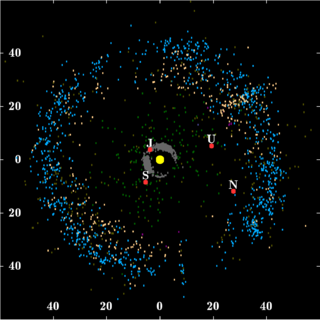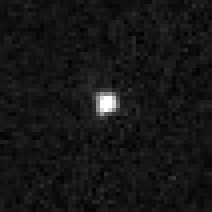Related Research Articles

In planetary astronomy, a centaur is a small Solar System body with either a perihelion or a semi-major axis between those of the outer planets. Centaurs generally have unstable orbits because they cross or have crossed the orbits of one or more of the giant planets; almost all their orbits have dynamic lifetimes of only a few million years, but there is one known centaur, 514107 Kaʻepaokaʻawela, which may be in a stable orbit. Centaurs typically exhibit the characteristics of both asteroids and comets. They are named after the mythological centaurs that were a mixture of horse and human. Observational bias toward large objects makes determination of the total centaur population difficult. Estimates for the number of centaurs in the Solar System more than 1 km in diameter range from as low as 44,000 to more than 10,000,000.

944 Hidalgo is a centaur and unusual object on an eccentric, cometary-like orbit between the asteroid belt and the outer Solar System, approximately 52 kilometers in diameter. Discovered by German astronomer Walter Baade in 1920, it is the first member of the dynamical class of centaurs ever to be discovered. The dark D-type object has a rotation period of 10.1 hours and likely an elongated shape. It was named after Mexican revolutionary Miguel Hidalgo y Costilla.
Damocloids are a class of minor planets such as 5335 Damocles and 1996 PW that have Halley-type or long-period highly eccentric orbits typical of periodic comets such as Halley's Comet, but without showing a cometary coma or tail. David Jewitt defines a damocloid as an object with a Jupiter Tisserand invariant (TJ) of 2 or less, while Akimasa Nakamura defines this group with the following orbital elements:
(65407) 2002 RP120, provisional designation 2002 RP120, is a trans-Neptunian object and damocloid from the outer Solar System. Its orbit is retrograde and comet-like, and has a high eccentricity. It was discovered on 4 September 2002 by astronomers with the LONEOS survey at Anderson Mesa Station, Arizona, in the United States. The unusual object measures approximately 14.6 kilometers (9.1 miles) in diameter and is likely elongated in shape. It is a slow rotator and potentially a tumbler as well. The object was probably ejected from the ecliptic by Neptune.
20461 Dioretsa is a centaur and damocloid on a retrograde, cometary-like orbit from the outer Solar System. It was discovered on 8 June 1999, by members of the LINEAR team at the Lincoln Laboratory Experimental Test Site near Socorro, New Mexico, United States. The highly eccentric unusual object measures approximately 14 kilometers in diameter. It was named Dioretsa, the word "asteroid" spelled backwards.
54598 Bienor is a centaur that grazes the orbit of Uranus. It is named after the mythological centaur Bienor. Its closest approach to the Sun (perihelion) is 13.2 AU. As of 2020, Bienor is 14.2 AU from the Sun and will reach perihelion in January 2028. It measured approximately 198 kilometers in diameter.
83982 Crantor, prov. designation: 2002 GO9, is a centaur in a 1:1 resonance with Uranus, approximately 60 kilometers (37 miles) in diameter. It was discovered on 12 April 2002, by astronomers of the Near-Earth Asteroid Tracking at the Palomar Observatory in California, United States. This minor planet was named for Crantor from Greek mythology.

31824 Elatus (, provisional designation: 1999 UG5) is a very red centaur from the outer Solar System, approximately 48 kilometers (30 miles) in diameter. It was discovered on 29 October 1999, by astronomers of the Catalina Sky Survey at Mount Lemmon Observatory in Arizona, United States. The minor planet was named after Elatus, a centaur from Greek mythology.
20898 Fountainhills, provisional designation 2000 WE147, is a dark asteroid in a cometary orbit (ACO) from the outermost regions of the asteroid belt, approximately 37 kilometers (23 miles) in diameter. It was discovered on 30 November 2000, by American amateur astronomer Charles W. Juels at the Fountain Hills Observatory in Arizona, United States. The D-type asteroid has a rotation period of 12.84 hours. It was named for the city of Fountain Hills, Arizona, in the United States.

32532 Thereus, provisional designation: 2001 PT13, is a centaur from the outer Solar System, approximately 80 kilometers (50 miles) in diameter. It was discovered on 9 August 2001, by astronomers of the Near-Earth Asteroid Tracking program at the Palomar Observatory in California, United States. This minor planet was named for the phrase thēreios bia 'beastly strength', used to describe centaurs in Greek mythology.
(248835) 2006 SX368, provisional designation: 2006 SX368, is a centaur, approximately 75 kilometers (47 miles) in diameter, orbiting in the outer Solar System between Saturn and Neptune. It was discovered on 16 September 2006, by American astronomers Andrew Becker, Andrew Puckett and Jeremy Kubica at Apache Point Observatory in Sunspot, New Mexico.
2000 DG8 is a dark centaur and damocloid on a retrograde and highly eccentric orbit from the outer region of the Solar System. It was first observed on 25 February 2000, by astronomers with the LINEAR program at the Lincoln Lab's ETS near Socorro, New Mexico, United States. It has not been observed since 2001. The unusual object measures approximately 16 kilometers (9.9 miles) in diameter.
(82158) 2001 FP185, provisional designation 2001 FP185, is a highly eccentric trans-Neptunian object from the scattered disc in the outermost part of the Solar System, approximately 330 kilometers in diameter. It was discovered on 26 March 2001, by American astronomer Marc Buie at Kitt Peak National Observatory in Arizona, United States.
(336756) 2010 NV1, prov. designation: 2010 NV1, is a highly eccentric planet crossing trans-Neptunian object, also classified as centaur and damocloid, approximately 52 kilometers (32 miles) in diameter. It is on a retrograde cometary orbit. It has a barycentric semi-major axis (average distance from the Sun) of approximately 286 AU.

(127546) 2002 XU93, provisional designation 2002 XU93, is a trans-Neptunian object and centaur on highly inclined and eccentric orbit in the outer region of the Solar System. It measures approximately 170 kilometers (110 mi) in diameter and is one of few objects with such an unusual orbit. It was discovered on 4 December 2002, by American astronomer Marc Buie at the Kitt Peak National Observatory in Arizona, United States.
2010 WG9 is a high inclination trans-Neptunian object and slow rotator from the outer Solar System, approximately 100 kilometers in diameter. It was first observed at ESO's La Silla Observatory in northern Chile on 30 November 2010.
(523727) 2014 NW65, provisional designation: 2014 NW65, is a large centaur from the outer Solar System, approximately 220 kilometers (140 miles) in diameter. It was discovered on 14 July 2010 by astronomers with the Pan-STARRS-1 survey at Haleakala Observatory, Hawaii, in the United States. According to American astronomer Michael Brown, it is "possibly" a dwarf planet. The minor planet was numbered in 2018 and has not been named.
(342842) 2008 YB3, provisional designation: 2008 YB3, is a sizable centaur and retrograde damocloid from the outer Solar System, approximately 67 kilometers (42 miles) in diameter. It was discovered on 18 December 2008, by astronomers with the Siding Spring Survey at the Siding Spring Observatory in Australia. The minor planet was numbered in 2012 and has since not been named.
(468861) 2013 LU28, provisional designation 2013 LU28 is a highly eccentric trans-Neptunian object, retrograde centaur and damocloid from the outer regions of the Solar System. It was discovered on 8 June 2013 by astronomers with the Mount Lemmon Survey at the Mount Lemmon Observatory in Arizona, United States. The object is unlikely a dwarf planet as it measures approximately 110 kilometers (68 miles) in diameter. It was numbered in 2016 and has not been named since.
In planetary science, the term unusual minor planet, or unusual object, is used for a minor planet that possesses an unusual physical or orbital characteristic. For the Minor Planet Center (MPC), which operates under the auspices of the International Astronomical Union, any non-classical main-belt asteroid, which account for the vast majority of all minor planets, is an unusual minor planet. These include the near-Earth objects and Trojans as well as the distant minor planets such as centaurs and trans-Neptunian objects. In a narrower sense, the term is used for a group of bodies – including main-belt asteroids, Mars-crossers, centaurs and otherwise non-classifiable minor planets – that show a high orbital eccentricity, typically above 0.5 and/or a perihelion of less than 6 AU. Similarly, an unusual asteroid (UA) is an inner Solar System object with a high eccentricity and/or inclination but with a perihelion larger than 1.3 AU, which does exclude the near-Earth objects.
References
- 1 2 3 4 5 "2011 MM4". Minor Planet Center. Retrieved 18 October 2018.
- 1 2 3 4 5 6 "JPL Small-Body Database Browser: 2011 MM4" (2017-10-29 last obs.). Jet Propulsion Laboratory . Retrieved 18 October 2018.
- 1 2 3 4 Johnston, Wm. Robert (7 October 2018). "List of Known Trans-Neptunian Objects". Johnston's Archive. Retrieved 17 October 2018.
- ↑ "List Of Centaurs and Scattered-Disk Objects". Minor Planet Center. Retrieved 18 October 2018.
- 1 2 3 Bauer, James M.; Grav, Tommy; Blauvelt, Erin; Mainzer, A. K.; Masiero, Joseph R.; Stevenson, Rachel; et al. (August 2013). "Centaurs and Scattered Disk Objects in the Thermal Infrared: Analysis of WISE/NEOWISE Observations". The Astrophysical Journal. 773 (1): 11. arXiv: 1306.1862 . Bibcode:2013ApJ...773...22B. doi:10.1088/0004-637X/773/1/22. S2CID 51139703.
- ↑ Peixinho, N.; Doressoundiram, A.; Delsanti, A.; Boehnhardt, H.; Barucci, M. A.; Belskaya, I. (October 2003). "Reopening the TNOs color controversy: Centaurs bimodality and TNOs unimodality". Astronomy and Astrophysics. 410 (3): L29–L32. arXiv: astro-ph/0309428 . Bibcode:2003A&A...410L..29P. doi:10.1051/0004-6361:20031420. S2CID 8515984.
- 1 2 de la Fuente Marcos, C.; de la Fuente Marcos, R. (August 2014). "Large retrograde Centaurs: visitors from the Oort cloud?". Astrophysics and Space Science. 352 (2): 409–419(Ap&SSHomepage). arXiv: 1406.1450 . Bibcode:2014Ap&SS.352..409D. doi:10.1007/s10509-014-1993-9. S2CID 189843380.
- ↑ "LCDB Data for (342842)". Asteroid Lightcurve Database (LCDB). Retrieved 18 October 2018.